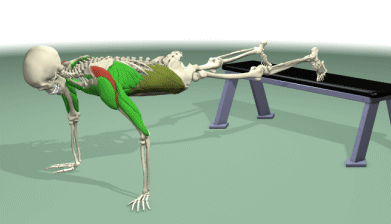




THE FITNESS
DIGEST.
The Hula Hoop is back and more sophisticated than ever, offering numerous benefits when used in an exercise routine. By swinging your hips around, you tone every angle of your torso and get a fantastic cardiovascular workout to boot. Hooping can also improve your grace and coordination.
Instructions
-
Buy yourself a Hula Hoop. Make an investment in a weighted hoop for better results. A hula hoop weighing two pounds or less is good for beginners, or those who wish to maximize the amount of time they can exercise.
-
Warm up for a few minutes by jogging or doing some jumping jacks.
-
Begin your routine by challenging yourself to hooping for two 10-minute intervals.
-
Move your arms for an even more challenging workout. Once you're comfortable with the basic hooping routine, try adding some arm movements. You could punch, swing or wave; whatever gets you energized. This will increase your heart rate and burn more calories than moving your hips alone.
-
Join a hooping class or buy a DVD to get more from exercise with a Hula Hoop. If you find yourself enjoying hooping and want to take it to the next level, there's nothing like a guided workout. Many routines teach you to dance with the hoop, for a full body workout.
Please note:-
Weighted hula hoops can be a good addition to your exercise program, especially if you're able to hula hoop for at least 10 minutes at a time. In fact, any type of hula hooping, with a weighted hula hoop or a regular hula hoop can help you meet your exercise goals.
Weighted hula hoops are bigger and heavier than traditional hula hoops. You can use a weighted hula hoop as part of an overall fitness program, to add variety to your workouts, or simply as a fun way to get more active. Keep in mind that for most healthy adults, the Department of Health and Human Services recommends getting at least 150 minutes a week of moderate aerobic activity or 75 minutes a week of vigorous aerobic activity.
If you try a weighted hula hoop, use a hula hoop that's the right size for you. The hoop should reach somewhere between your waist and chest when it's resting vertically on the ground. The weight of the hoop is up to you. The smaller and lighter the hoop, the more energy it takes to keep the hoop going. But the bigger and heavier the hoop, the easier it is keep going, which means you may be able to do it for a longer period of time. You can experiment with different hoops to see which kind and size you prefer. Weighted hula hoops are available at many sporting goods stores and online retailers, and even at some fitness clubs.
Check with your doctor before using any kind of hula hoop if you have medical concerns, especially a history of back problems. And as with any physical activity, stop hula hooping and consult your doctor if you develop pain or other symptoms.
How to Hula Hoop


Physical fitness Disclaimer and Waiver of liability:
Exercises are not without their risks and the exercise programs in this website may result in injuries.Any person who undertakes these exercises does so at their own risk.To reduce the risk of injuries ,you should consult your doctor before beginning these or any other exercise programs.As with any exercise program ,if at any point during your workout you believe conditions to be unsafe or begin to feel faint or dizzy,have physical discomfort or pain, you should stop immediately and consult a physician.
Daily exercise for Working women.
Jumping Jacks. . Effective workouts.
Group exercise and its benefits.
Calf raises-free style . Push ups.
Tummy exercises. Hoola Hooping .
Fitness Motivational tips. Barbell Squauts.
The myths of spot reduction. Leg press.
Standing calf raises. Concentration curls.
Bench (Tricep) dips.. One arm dumbbell rows.
Pec deck Flye. Fr0nt dumbbell raises. Glute ham raise.
Seated leg curl . Close grip bench press .
.

Please keep comments positive and constructive.
Help the WEBSITE by reporting inappropriate comments to thefitnessdigest@gmail.com . Inappropriate comments may be reported and/or removed.